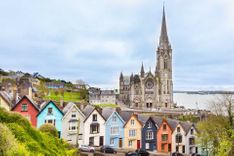Is Ireland a good destination for families?
Absolutely! Visiting Ireland with kids can be an absolute joy, thanks to the country’s welcoming spirit, fun cultural attractions, magical castles, expansive beaches, and amazing wildlife watching experiences.
Also being very safe and easy to get around (more on that later), with excellent infrastructure, Ireland is primely placed for families with kids of all ages to enjoy vacations that can be as adventurous or chilled as you fancy.
Best family-friendly destinations in Ireland
Whether you want to go wild in Ireland’s great outdoors, or discover culture through castles, museums, festivals and food, here are some of the best places to visit in Ireland with kids.
Dublin
Dublin is simply loaded with family attractions, including Dublin Zoo, Emerald Park (a nearby theme park with rides for all ages and a zipline course), Dublinia, where kids can play at being a Viking warrior, and the National Leprechaun Museum.
Just outside the city, the 400-year-old medieval Malahide Castle Malahide Castle offers a fairy trail, a walled botanical garden, a butterfly house, and stacks of secret passageways. See our guide to how many days in Dublin you should spend.
Galway
Located on the west coast, Galway charms with its colorful streets, buskers, and access to top family-friendly day trip destinations like the Aran Islands, Connemara National Park, and Kylemore Abbey.
It’s also at the heart of the scenic Wild Atlantic Way drive, where the Cliffs of Moher boast breathtaking ocean views and child-friendly exhibits about local wildlife in the visitor center.
Killarney
Another standout destination for families, Killarney is located in a national park that’s loaded with lakes, castles, and wildlife. As such, families can enjoy boat trips and nature trails, with Muckross House on hand for rural cultural experiences.
Meanwhile, the nearby Dingle Peninsula boasts sandy beaches, sea life centers, and dolphin-spotting tours. See more about Ireland wildlife.
Kilkenny
Blending medieval charm with access to family attractions, Kilkenny is pleasingly compact and makes a culture-rich getaway destination.
With its grand medieval halls, child-oriented interactive tours, huge playground, and spacious gardens, medieval Kilkenny Castle is a real highlight for families.
Meanwhile, the Medieval Mile Museum brings local history to life with family-friendly exhibits, with the River Nore offering relaxing riverside walks and wildlife-spotting opportunities.
When the need for adventure strikes, a short drive will take you to Castlecomer Discovery Park, where kids can go ziplining and enjoy treetop walks and nature trails.


















